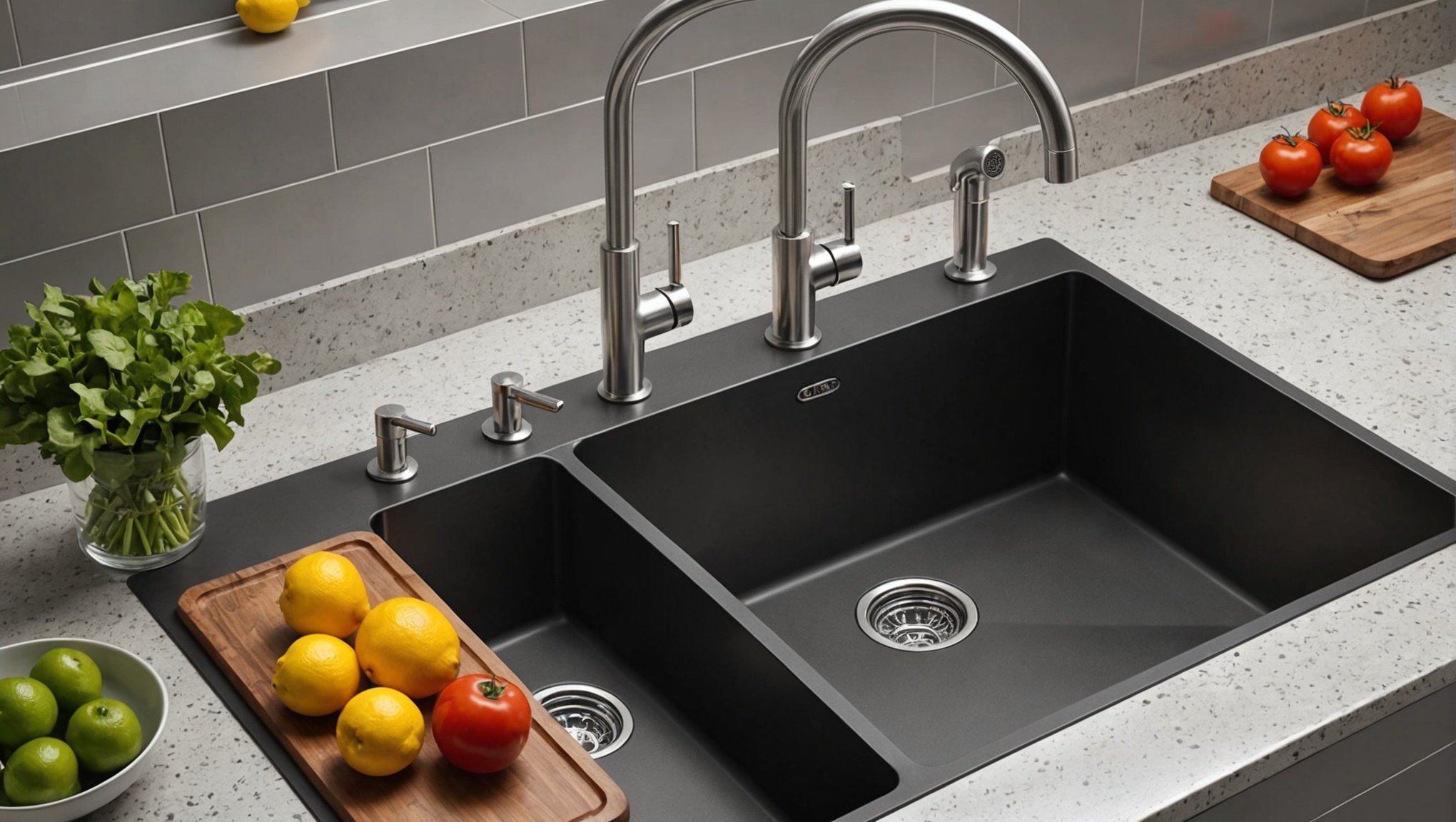A kitchen sink is more than just a functional fixture; it embodies style and health. For health-conscious home chefs, selecting the right sink means considering material, hygiene, and aesthetics. Modern sinks blend durability and design, accommodating everything from meal prep to cleanup. Explore our top picks that seamlessly merge elegance and practicality, transforming your kitchen into a haven for culinary creativity. These stylish solutions ensure you can focus on what matters most: preparing delicious, healthy meals while enjoying a beautiful, functional space.
Introduction to Stylish and Functional Kitchen Sinks
In modern kitchens, kitchen sinks are more than just practical necessities; they are central to health-conscious cooking and stylish kitchen fixtures. A well-chosen sink can enhance both the aesthetics and functionality of your kitchen. When selecting a sink, consider how it will balance style and practicality to suit your cooking habits and design preferences.
Functional sinks are crucial for maintaining hygiene and efficiency in the kitchen. They should accommodate various tasks, from washing vegetables to cleaning up after meals. Features like deep basins, durable materials, and easy-to-clean surfaces contribute to their functionality. Stainless steel and granite composite are popular choices due to their resilience and sleek appearance.
On the style front, kitchen sinks can be a focal point that complements your kitchen’s overall design. Whether you prefer a farmhouse, undermount, or apron-front style, there are numerous options to match your taste. The right sink can seamlessly integrate with your countertops and cabinetry, creating a cohesive look.
Additional reading : Elevate Your Small Kitchen: The Impact of Pull-Out Pantry Systems on Accessibility and Healthy Eating Habits
When selecting a kitchen sink, consider key features such as size, material, and installation type. These elements will ensure that your sink not only meets your functional needs but also enhances the visual appeal of your kitchen.
Materials That Promote Hygiene
Choosing the right sink materials is essential for maintaining a hygienic kitchen environment. Among the most popular options are stainless steel sinks, composite materials, and ceramic. Each of these materials offers unique benefits, particularly in terms of cleanliness and durability.
Stainless steel sinks are a top choice for hygienic kitchens due to their non-porous surface, which resists bacteria and germs. Their smooth surface is easy to clean, making it simple to maintain a sanitary kitchen. Additionally, stainless steel is highly durable, resisting scratches and stains.
Composite sinks, often made from a blend of granite and resin, also offer excellent hygiene benefits. These sinks are non-porous, meaning they don’t absorb liquids or harbour bacteria. Their hard surface is not only hygienic but also scratch-resistant, ensuring longevity and ease of maintenance.
Ceramic sinks, while less common, provide a classic look and are also non-porous. This feature makes them easy to clean and resistant to bacteria build-up. However, they can be more prone to chipping compared to stainless steel and composite options.
When selecting a sink, consider how the material affects both health and hygiene, ensuring a clean and functional kitchen space.
Design Options for Every Kitchen Style
In the world of kitchen sink designs, there are numerous stylish sink options available to suit any aesthetic preference. Whether you’re aiming for a rustic, contemporary, or minimalist look, there’s a sink design to match your kitchen’s style.
Farmhouse sinks, known for their deep basins and exposed fronts, offer a classic charm that fits well in traditional and rustic kitchens. They are not only functional but also serve as a striking focal point.
Undermount sinks provide a seamless look by being installed beneath the countertop, making them ideal for modern sink aesthetics. Their sleek design complements contemporary kitchens, allowing for easy cleaning and a clutter-free appearance.
Drop-in sinks, also known as top-mount sinks, are versatile and easy to install. They come in various shapes and sizes, catering to different kitchen themes and layouts.
When considering color and finish trends, matte black, brushed gold, and classic stainless steel are popular choices that enhance kitchen aesthetics. These finishes can add a touch of elegance or modernity, depending on the overall theme.
Integrating the right sink design into your kitchen can elevate its style, creating a harmonious and visually appealing space.
Features That Enhance Functionality
In the quest for optimal kitchen sink functionality, several practical sink features stand out. A key element is the deep basin, which is essential for accommodating larger pots and pans. This feature not only makes cleaning more efficient but also reduces splashing, keeping your kitchen tidier.
Another innovative addition is integrated cutting boards and colanders. These accessories transform your sink into a multitasking hub, allowing you to chop vegetables and rinse them simultaneously. This integration saves counter space and streamlines meal prep, making your kitchen experience more efficient.
The type of faucet you choose plays a significant role in enhancing sink performance. Pull-down and pull-out faucets offer flexibility and reach, making it easier to clean large items and fill pots. Touchless faucets add a layer of convenience and hygiene, allowing you to operate them without touching the handles, which is especially useful when your hands are full or dirty.
When selecting a sink, consider these functional features to improve your kitchen’s efficiency. By choosing the right combination of deep basins, integrated accessories, and versatile faucets, you can create a kitchen space that is both practical and enjoyable to use.
Health Benefits of Choosing the Right Sink
Selecting the right sink can significantly impact food safety in kitchens. A sink designed with hygienic sinks in mind can enhance health benefits by reducing the risk of contamination. Materials like stainless steel and composite are known for their easy-to-clean surfaces, which play a crucial role in preventing bacteria growth. These non-porous surfaces ensure that germs do not have a place to thrive, making it easier to maintain a clean environment.
User testimonials often highlight how choosing a sink with a deep basin and integrated accessories contributes to health-conscious cooking. These features allow for efficient washing and preparation of food, minimizing the risk of cross-contamination. Users report that sinks with integrated cutting boards and colanders streamline their cooking process, providing a dedicated space for each task and maintaining cleanliness.
Moreover, the design of a sink can influence food safety practices by encouraging better hygiene habits. For instance, touchless faucets can prevent the spread of germs, as they eliminate the need to touch handles with dirty hands. By selecting a sink that combines functionality with hygiene, you can create a kitchen environment that supports both health and efficiency.
Top Stylish Kitchen Sink Recommendations
Finding the best kitchen sinks involves balancing aesthetics, functionality, and value for money. Here, we present a curated selection of recommended sinks that excel in both style and practicality.
Recommended Sinks and Their Features
- Kraus Standart PRO: Known for its sleek design and durable stainless steel construction, this sink offers excellent noise reduction and resilience. Its deep basin is perfect for accommodating large cookware, enhancing kitchen efficiency.
- Ruvati Workstation Ledge: This versatile sink integrates a ledge for accessories like cutting boards and colanders, transforming your sink into a multifunctional workspace. Its modern look and practicality make it a top choice for contemporary kitchens.
- Blanco Silgranit: Made from a granite composite, this sink is both stylish and resistant to scratches and stains. Its non-porous surface ensures easy cleaning and hygiene, making it ideal for busy kitchens.
Price Range and Value
- Kraus Standart PRO: Typically priced between £200-£300, offering durability and style at a reasonable cost.
- Ruvati Workstation Ledge: Priced around £350, it provides excellent value with its integrated features.
- Blanco Silgranit: Ranges from £250-£400, balancing quality and aesthetic appeal.
These stylish sink options provide a blend of elegance and practicality, enhancing any kitchen space.
User Reviews and Comparisons
Exploring user reviews and sink comparisons can provide valuable insights into choosing the right kitchen sink. Customer feedback on sinks often highlights the balance between functionality and style, offering a practical perspective on popular models.
Summary of User Feedback
Many users appreciate sinks with deep basins and integrated accessories, noting their impact on kitchen efficiency. Customer feedback on sinks like the Kraus Standart PRO often praises its noise reduction and robust construction. Similarly, the Ruvati Workstation Ledge receives positive reviews for its multifunctional design, which includes a ledge for accessories.
Comparison of Top-Rated Sinks
When comparing top-rated sinks, functionality and style are key considerations. The Kraus Standart PRO is lauded for its durability and sleek appearance, making it suitable for various kitchen styles. The Ruvati Workstation Ledge stands out for its versatility, offering a modern aesthetic and practical features. Meanwhile, the Blanco Silgranit is favoured for its stylish granite composite material and ease of cleaning.
Insights from Health-Conscious Chefs
Health-conscious chefs often choose sinks that support hygienic cooking practices. They value materials like stainless steel and granite composite for their non-porous surfaces, which help maintain cleanliness. These insights can guide consumers in selecting a sink that meets both aesthetic and practical needs.
Maintenance Tips for Longevity and Hygiene
Proper sink maintenance is essential for ensuring both longevity and hygiene in your kitchen. Regular care helps prevent damage and keeps your sink looking pristine.
Best Practices for Cleaning
Different materials require specific cleaning tips. For stainless steel sinks, use a mild detergent and soft cloth to avoid scratches. Rinse thoroughly to prevent water spots. For composite sinks, a gentle scrub with baking soda and water can remove stains without harming the surface. Ceramic sinks benefit from regular wiping with a non-abrasive cleaner to maintain their classic shine.
Preventing Stains and Scratches
To prevent stains, avoid leaving acidic or colourful foods in the sink for extended periods. Use a sink grid to protect against scratches, particularly with stainless steel and ceramic options. Regularly clean the grid to prevent residue build-up.
Importance of Regular Maintenance
Maintaining kitchen sinks regularly is crucial for hygiene. A clean sink reduces the risk of bacteria growth, ensuring a healthier kitchen environment. Regular checks for leaks or blockages can prevent more significant issues, preserving your sink’s functionality and appearance. By following these sink maintenance practices, you can extend the lifespan and enhance the hygiene of your kitchen sink.
Innovations in Kitchen Sink Technology
In recent years, innovative sink features have transformed kitchen design, introducing a new era of functionality and hygiene. Smart kitchen sinks are at the forefront of this transformation, integrating technology to enhance daily kitchen tasks.
Smart sinks often include touchless faucets, which reduce water wastage and improve hygiene by allowing users to operate them without physical contact. This technology is particularly beneficial in preventing the spread of germs, making it a smart choice for health-conscious kitchens.
Another advancement is the integration of technology in kitchen design through features like built-in water filtration systems. These systems ensure that the water used for cooking and cleaning is pure, promoting a healthier kitchen environment.
Looking ahead, future trends in kitchen sink design are likely to focus on sustainability and efficiency. Innovations such as sinks with built-in composting systems or energy-efficient water heating are on the horizon. These developments aim to make kitchens more eco-friendly while maintaining convenience and style.
The rise of smart kitchen sinks signifies a shift towards a more technologically advanced and hygienic kitchen space, aligning with modern needs and preferences.
Conclusion and Final Thoughts
Selecting the right kitchen sink choices is pivotal in crafting a kitchen that is both stylish and functional. A well-chosen sink not only enhances the aesthetic appeal of your space but also plays a crucial role in maintaining a hygienic environment. In health-conscious kitchens, prioritising sinks made from materials like stainless steel and composite can significantly reduce the risk of bacterial build-up, ensuring a safer cooking area.
When considering your kitchen design, it’s essential to balance style with practicality. Opt for sinks that complement your design theme while offering features that support your daily kitchen activities. Deep basins, integrated cutting boards, and touchless faucets are examples of innovations that enhance both functionality and efficiency.
Encourage yourself to explore various sink options that align with your specific needs and preferences. Whether you favour a modern, rustic, or minimalist look, there are numerous designs available that can transform your kitchen into a space of both beauty and utility. By making informed kitchen sink choices, you can ensure that your kitchen not only meets your aesthetic desires but also supports a healthy and efficient cooking environment.






